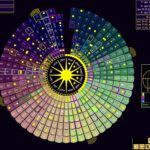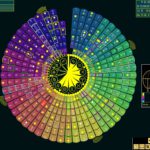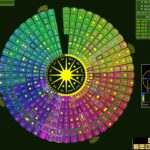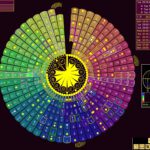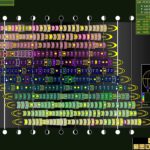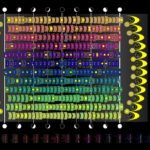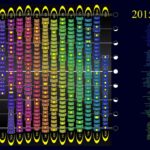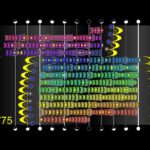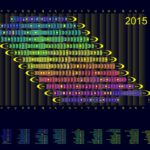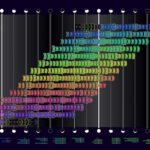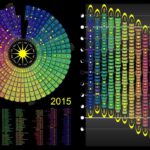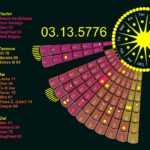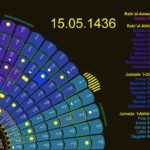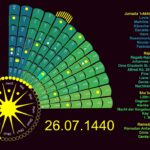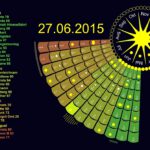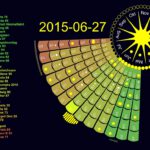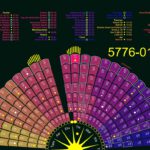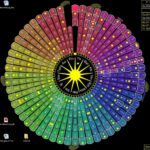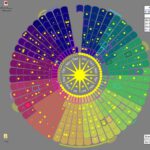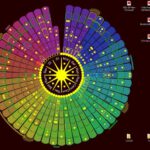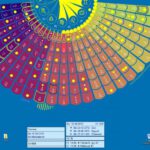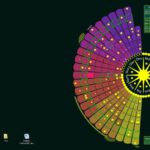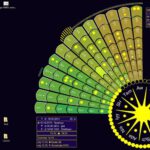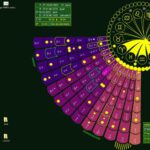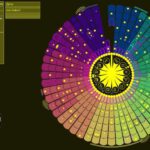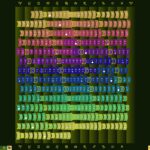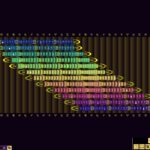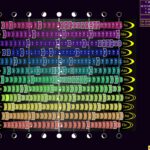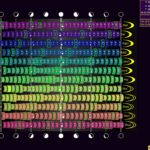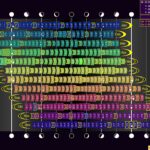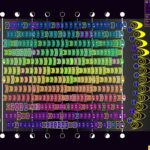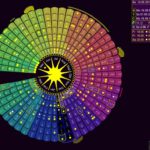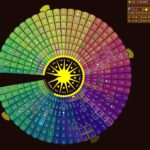Circular and moon calendar
Contents: (hide/show)
- Calendar program – annual overview, circular or in monthly stripes
- Lessing ring, contribution to the Abrahamic Trialogue
- Galery: From north to south in circle mode and back to north in stripe mode…
- Galery: Print examples
- Galery: Print postcards
- Galery: Desktop options, circle mode
- Real lunar calendar
- Easter Style
Calendar Program – annual overview, circular or in monthly stripes
The program serves three purposes:
- First, it can be used as a birthday calendar. You may be pleased with the „starry sky“ of those you love, with the overview of the distribution of birthdays in the year. Occasionally you open the program to see who has to be celebrated in the coming weeks…
- In the same way but more intense you can use it as your desktop background, so you get the info of the current week on your screen, by that way it may become useful for your appointments.
- Second, you can create templates for posters, then hang them up as an aesthetic „clock of the Year“. You can mark the week every Sunday with adhesive labels. The months also.
- Or templates for postcards – in quadrant or semicircle versions a day you wish can be brightened and set centrally, thus creating an individual birthday card.
- Finally, it can serve for teaching: lucid and concrete the relation between the different calendars can be shown. – As well their relation to the moon phases. – As moving time zones moves the moon phase data, and by this way, for example, show how the three versions of the Islamic calendar make sense in different regions of the world. How different time last the quarters of the moon phases. How different „fast“ the moon passes through the zodiac (- by this way, in addition to the synodic and tropical or sidereal month also the anomalistic month may be vividly experienced!)
Click here to <<download>> and to see illustrations of configuration and menus.
– As a new Lessing ring, as a contribution to the Abrahamic Trialogue:
This calendar should serve people of all cultures, facilitate the dialogue between religions and match in all places of the earth:
- In addition to the international calendar, there are options for Jewish, Julian and Islamic style. Depending of the choosen language there is a basic packages of holidays. Wich are customizable, you can create your own holidays in all styles and 7 colors.
There is the international calendar in a new conception and layout, as a new style which combines solar and lunar cycles. This brings to bear the wisdom of its form. (Also possible in julian version.)
Another new feature is the Easter style, which sets Eastern itself as New Year, so uses its overcoming of the Sun-Moon polarity and reveal veryinteresting aspects.
(More Styles will follow, hopefully soon.)- The current data of all styles are switchable, all further information may be displayed in these.
- The styles can be combined, for example, you may show the year 2015 sorted in Jewish months and filled with Islamic data …
- The seasonal colors can be changed freely in the equatorial zone without well defined seasons, they can be set matching to both hemispheres, thus the southern as the northern. Also the moon phase characters tend accordingly.
There is the article, only in german yet.
From north to south in circle mode and back to north in stripe mode – 6 geographical zones, 12 languages and 6 calendar styles:
Print examples:
Print Postcards:
Desktop options, circle mode:
Real lunar calendar
All so-called lunar calendar, which I found in paper or internet, are not really such a thing: They are mostly just the usual calendar assorted as usual with information about the moon, partly as text, often with pictures of the phases.
Here it´s shown for the first time a calendar that truly and clearly places the days in relation to the lunar cycles, not setting them in abstract way in columns of same month data or same days of the week.
The moon rhythm itself gives the measure: the days are spread inline the same moon phases in case of synodic, inline the same lunar mansions in case of tropical or sidereal stripe mode:
- A wonderful texture of directions becomes visible, best in first picture: lunar mansion stripes, skewed lines of equal phases of the moon and – at a different angle again – those of same days of the week!
- The relationship between synodic and sidereal month becomes visible, each synodic month begins one moonhouse after, the moon-loyal month-sorting of Jewish, Muslim and also the new style show it, best example is the third image. Because 13 sidereal months correspond to 12 synodical months. (The other way round each sidereal month begins a 13th phase-cycle shifted.)
- Nearly one day only is the difference between 12 synodic and 13 sidereal months – 354.37 days and 355.17 days.
- The anomalistic month can be experienced: The greater density of day fields shows the moon perigee, the lower density its apogee. At the moment the perigee is located in sidereal Leo, it moves on very slowly, since the anomalistic period is only slightly longer than the sidereal.
With this some things become clear:
- You can see well that the existing Jewish and Islamic synodical calendars reflect real lunar months, but too, that they do it out of focus and this cannot be different: the moon does not add up in the sequence of days or vice versa. Every month begins nearly a half-day shift and the next phase quarteronce happenthe sixth day after, sometimes the Ninth!
- You see, how Julian and Gregorian „months“ are not month but shift in relation to it.
- You can recognize, how the „New Calendar“ recombine loyalty to seasons with genuine lunar months, soothes the blurring of all other systems by the month „hug“ of the 12 nights rounding.
Easter Style
„With the determination of the date of Easter the primal polarity of sun and moon has been overcome in a very peculiar way: First, wait for the spring equinox as a tribute to those who follow the sun. Then the full moon should appear, as salute to those who are following the moon. And thirdly, the Sunday will be waited as homage to human beiing who invent the 7-day week. Perhaps token as a quarter of one month, but he gave the week the Sunday – the following Sunday after the full moon after the Spring equinox is Easter.“ This is the date of Easter, very changeable, it may be every day from March 22 to April 25, at least a period of 5 weeks.
Now in this program there is as new calendar style: the „Easter style“.
However, it is not really new, in the Middle Ages very different beginnings of the year were usual, among others the so-called Easter- or Paschalstyle too. It was only in the late Middle Ages that the first of January increasingly prevailed. Pope Innocent XII (1615-1700) realized in 1691 January 1 as beginning of the year.
In this style Easter is new year and therfore it has the whole movement of Easter in all the calendar.
A mobility that is worth to look at it in more detail:
First there is importante to look the underlying lunisolar calendars. These are true synodic lunar calendars, are based on the real moon so that they form from 12 months a year celebrating New Year after 12 months. With the aim to remain fitting the running seasons, in every third or sometimes even second year a thirteenth intercalary month is add, covering the difference between lunar and solar year.
The Jewish calendar is among them something special, with some extra provisions it is achieved that certain calendar dates can fall only on certain weekdays. With this fact for the first time the week as a sequence of qualitatively different days got a calendar determining significance.
This is exactly what becomes complete reality by the Easter calendar: the weekday sequence determines the whole calendar. Each year always begins with a Sunday and ends on a Saturday. This means that the months may not have a calendar determining function within the year anymore. So the Easter years indeed have different lengths depending on whether they are based on a 12-month or 13-month Lunisolarjahr but they dont last 12 and 13 months but in the first case 50 or 51 weeks in the rarer second one 54 or 55. (F.E.: in the years between 1900 und 2200 there exist 120 years with 51, 92 with 55, 70 with 50 and 19 with 54 weeks!)
If the days of this calendar would be dated in its style, consequently the weeks instead of months would have to be counted. Each day belongs to a particular week. The date would be shorter: today we use 5 informations for a complete date in the international calendar, here three are enough. Instead of the weekday, week number, day of month, month and year in eastern case weekday, week number and year would be sufficient. Today we have „Tuesday, 24.week, 9 of June 2015“, in Easter calendar it is „10th Tuesday, 1982 „
Leading a perpetual calendar in this style, all the data would occure always on the same days of the week, a „Sunday child“ would have birthday on a Sunday, every year, the whole life.
The medieval users of such style in any case used the dating of the Julian or Gregorian later. Staying with this common international date, in a few years, however, some dates would occure twice, in the period between March 22 and April 25th both at the beginning as at the end of the year. In the years with 55 weeks exactly 20 days, or in those with 54 weeks 13 days (19 or 12, if they contain a February 29) – if mentioned the international date of one of these days, you couldnt know wether it is at the beginning of the year or at its end…
Problems arises when using a style-own date: the question of weeks beyond the 50th as quasi leap weeks – how to deal with birthdays from this period?
The idea for the calendar style is based new on a calendar attempt of Rudolf Steiner, described in a lecture „Secrets of the kingdom of heaven in parables, in actual form,“ hold in Cologne on May 7, 1912, for members of the Theosophical Society, GA 143 at the bottom. In the pdf page 163/164.
However, this has not been operated further.
(The inherent perceived „soul calendar“ is quite vived, with its start on easter it refers indeed partly to the Easter celebrations, but with its 52 weekly quotes each year it is always understood seasonal, so in direct and stationary relation to the solar year (or more precisely… to the seasonal mood in Central Europe), since the data and holidays in the international calendar dont fall on equal weekdays, in each year the user must see – with some leeway – wich quote applies better to wich week. In spite of (the mentioned lecture) explicit emphasis on the value of the mobility of Easter this fact dont rules the soul calendar, it is on the one hand determined by the seasons, as a true solar calendar and on the other hand of the week as a real unit.)
The reason to program this calendar style is its own aesthetic, the interesting aspect of the weekday equality so beautifully revealed in the loop display, the vivid movement of its different duration. Even more in taht aspects than in the belief that the resurrection is the far more important date for humanity and Christianity as the birth. (The latter importance could even be manifested with a counting from 33, for example, with March 1 as a solid start of the year?)
